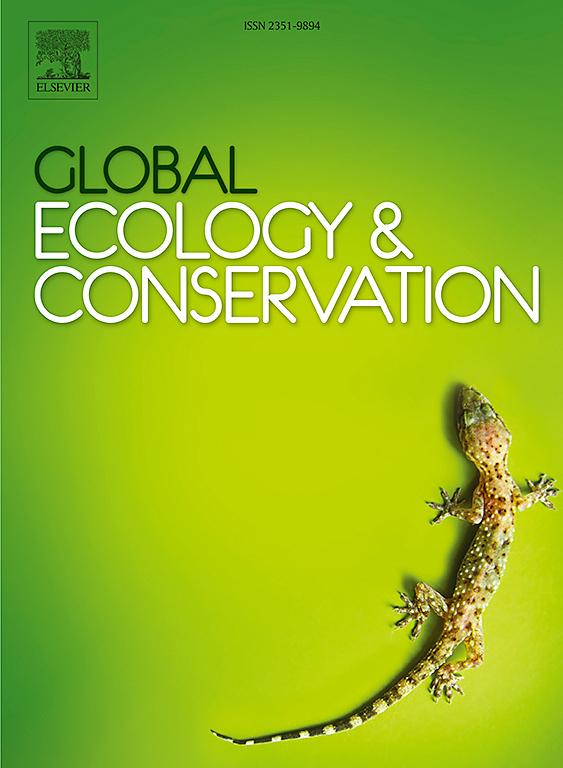Integrating LiDAR and ecological metrics to quantify habitat suitability for the platypus (Ornithorhynchus anatinus)
IF 3.4
2区 环境科学与生态学
Q1 BIODIVERSITY CONSERVATION
引用次数: 0
Abstract
Understanding habitat selection and population dynamics is critical for the conservation of the platypus (Ornithorhynchus anatinus), a freshwater species endemic to eastern Australia. This study integrated LiDAR-based habitat modelling, radio-tracking, and ecological assessments to examine habitat suitability and social interactions within a semi-wild platypus population in Tidbinbilla Sanctuary, Australian Capital Territory. Live trapping and radio-tracking of 15 individuals documented movements, burrow use, and foraging behaviours, while high-resolution LiDAR data characterised riparian habitat features. The study revealed a high population density of 6.7 platypuses per hectare, with 21 confirmed individuals occupying the Sanctuary’s waterbodies. Over 32 days of tracking, 31 burrows were identified, with individuals using between one and seven burrows, including six shared burrows, one of which housed five individuals concurrently. Burrow-sharing rates were substantially higher than previously reported. Spatial use was clustered into two distinct hotspots, which could not be fully explained by connectivity or prey availability. Instead, central regions were disproportionately favoured, suggesting that resource-independent factors, such as regional centrality and burrow complexity, influenced habitat selection. LiDAR-based habitat suitability models achieved 85 % accuracy in predicting burrow locations, with elevation and foliage projective cover identified as key predictors. Neither food nor burrow availability significantly influenced habitat selection, indicating both were sufficiently abundant. Instead, factors such as regional centrality emerged as key drivers of habitat use. These findings highlight the applicability of LiDAR-based methodologies for assessing habitat suitability in riparian ecosystems and provide a scalable approach for freshwater biodiversity conservation.
基于激光雷达和生态指标的鸭嘴兽栖息地适宜性量化研究
鸭嘴兽(Ornithorhynchus anatinus)是澳大利亚东部特有的淡水物种,了解其栖息地选择和种群动态对保护鸭嘴兽至关重要。本研究综合了基于激光雷达的栖息地建模、无线电跟踪和生态评估,研究了澳大利亚首都领地Tidbinbilla保护区半野生鸭嘴兽种群的栖息地适宜性和社会互动。现场捕捉和无线电跟踪记录了15个个体的活动、洞穴使用和觅食行为,而高分辨率激光雷达数据描述了河岸栖息地的特征。研究显示,鸭嘴兽的种群密度很高,每公顷6.7只,其中21只已确认占据了保护区的水体。在32天的跟踪中,确定了31个洞穴,个体使用1到7个洞穴,包括6个共用洞穴,其中一个洞穴同时容纳5个个体。租房率比之前报道的要高很多。空间利用聚集成两个不同的热点,这不能完全用连通性或猎物可用性来解释。相反,中部地区更受青睐,这表明资源独立因素,如区域中心性和洞穴复杂性,影响了栖息地的选择。基于激光雷达的生境适宜性模型预测洞穴位置的准确率达到85% %,海拔和植被投影覆盖被确定为关键预测因子。食物和洞穴的可用性都没有显著影响栖息地选择,表明两者都足够丰富。相反,区域中心性等因素成为了生境利用的关键驱动因素。这些发现突出了基于激光雷达的方法在评估河岸生态系统生境适宜性方面的适用性,并为淡水生物多样性保护提供了一种可扩展的方法。
本文章由计算机程序翻译,如有差异,请以英文原文为准。
求助全文
约1分钟内获得全文
求助全文
来源期刊

Global Ecology and Conservation
Agricultural and Biological Sciences-Ecology, Evolution, Behavior and Systematics
CiteScore
8.10
自引率
5.00%
发文量
346
审稿时长
83 days
期刊介绍:
Global Ecology and Conservation is a peer-reviewed, open-access journal covering all sub-disciplines of ecological and conservation science: from theory to practice, from molecules to ecosystems, from regional to global. The fields covered include: organismal, population, community, and ecosystem ecology; physiological, evolutionary, and behavioral ecology; and conservation science.
 求助内容:
求助内容: 应助结果提醒方式:
应助结果提醒方式:


